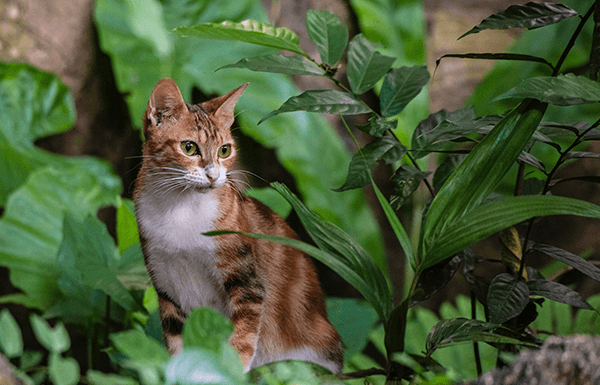Do you love flowers and greenery and keep a lot of plants in and around your home that your dog or cat can nibble?
If so, you’ll want to pay particular attention to the following list of plants that can be quite dangerous to the four-legged members of your family.
Before I list out some of the type of plants that can be detrimental to your pet’s health, I’d like to tell you something that a cat told me during one of my communication sessions.
Sophie called me one day asking me about her beloved cat, Nala. She told me that she had a healthy, vibrant, and extremely energetic disposition. However, it had been a week now, that Nala couldn’t keep anything in her tummy. She vomited everything she ate. She was getting progressively weaker due to the diarrhea, and had stopped playing altogether. She began meowing in pain and her guardian couldn’t understand what the problem was.
When I spoke to Nala, she told me she felt extremely nauseous all the time, her stomach was upset, and she felt like her tongue was slightly swollen. She said, and I quote, “I feel like there are rumbling waves in my tummy that I can’t control”. I then asked her what she thought happened to cause her to feel that way. She told me that her mum had bought a few plants for the house to try and make the living room more greener. When she was walking close to the plants, she was particularly attracted to the snake plant. She sniffed it, and it piqued her curiosity and so she began nibbling on it. She said, “I think I had too much to eat. It doesn’t make me feel so good.”
I know we all love plants in our homes. They add pops of color and a vibrant touch to even the blandest home interiors. They they also improve air quality, lower your stress levels, and generally make you happier. But what if those seemingly innocent buds are doing just the opposite? What if they’re actually doing more harm than good? And potentially harming your pets?
If you have a four legged family member, I urge you to please be more careful of what kind of plants you decide to purchase. It’s heartbreaking and beyond distressing to watch your pet go through what Nala experienced.
Some plants are far from harmless beauties — emitting toxins or poisonous sap. Are you wondering if you have some of these in your home?
Well Read on:
Snake Plant
Because they do just fine in low light, snake plants are common in office spaces and in homes. They’ve even been used as herbal remedies in some parts of the world. But the plants are also poisonous if ingested. Large doses can cause nausea and vomiting, and the poison found in the plant has a numbing effect that can cause the tongue and throat to swell. The plants are more toxic to dogs and cats, which can suffer from nausea, vomiting, and diarrhea.
Tulips
The entire tulip plant is toxic to your pet, but the bulbs are more poisonous than the leaves or stems. Tulip bulbs can cause serious gastrointestinal irritation, drooling, loss of appetite, depression of the central nervous system, convulsions and cardiac abnormalities.
Rhododendrons and Azaleas
Species of these plants contain grayanotoxin, a compound that will cause your dog or cat gastrointestinal symptoms including bloating, diarrhea and vomiting. Ultimately, ingestion of a lot of azaleas or rhododendrons can result in coma, cardiovascular collapse and death.
Oleanders
All varieties of the oleander plant are poisonous for both dogs and cats. More often, animals are poisoned by consuming the leaves. When ingested in large quantities, it can cause muscle tremors, colic, sweating, and sudden death from heart failure.
Cilantro
This plant can cause gastrointestinal irritation and cardiac arrhythmia in your pet.
Aloe Vera
While the gel may be good for humans to use, it is definitely not for consumption by pets. The plant contains a chemical called saponin, which is toxic to animals and children. Ingestion of aloe vera can cause excessive vomiting, breathing difficulties, coma, depressions, severe diarrhea, and low blood sugar.
Amaryllis
Though extremely beautiful, some of the symptoms of poisoning from the amaryllis, are vomiting, extreme weakness and depression.
English Ivy
Any species of the Ivy family contain a toxin called triterpenoids. This substance can cause your pet extreme gastrointestinal irritation which results in abdominal pain, vomiting and diarrhea.
Peace Lily
It is also known as the Mauna Loa plant, is a popular gift because it needs very little maintenance and blooms nearly nonstop. With a little water and a little sunlight, the peace lily can survive forever. Be careful though since this plant can cause severe irritation to your pet’s mouth, esophagus and stomach. Signs your dog or cat has ingested either of these plants are vomiting and diarrhea, drooling and difficulty swallowing.
Sago Palm
Do not be fooled by the adorable appearance of these plants— the leaves and seeds (all parts of the plants) are quite toxic. It is extremely dangerous to dogs. Symptoms include nosebleeds, lethargy, vomiting, paralysis or seizures, jaundice, and loss of appetite.
Foxglove
Foxglove is the most toxic just before the seeds begin to ripen. To give you an idea of just how poisonous this plant can be; ingesting only 0.5g of the dried plant is enough to kill a person. Imagine what it would do to your beloved furry friends. Symptoms include cardiac arrhythmias, cardiac failure, and death.
—
Depending on how a particular plant affects your pet’s body, and how much was ingested or inhaled, pet poisoning symptoms can range from vomiting to death. So when buying plants for your home, think twice, and opt for plants that are safe in case they decide to nibble on them.
